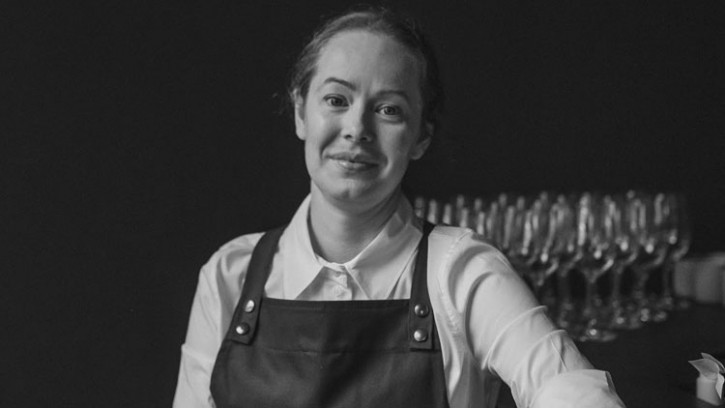Charting success: Roberta Hall McCarron on her Leith mini empire

Opening a restaurant by mistake is not unprecedented but it is unusual. Roberta Hall McCarron and her husband Shuan were content with their two Leith ventures but when the opportunity to take on the wine bar next to their The Little Chartroom flagship came up it was hard to pass up.
“Ardfern was completely unplanned. We’re good friends with the owners (of Mistral). When they said they were thinking of moving to France Shuan’s ears pricked up. The site ticks a lot of boxes for us and it being so close to The Little Chartroom means we can use it for extra storage and to put odds and ends from menu changes to good use.”
The move – which has seen the hitherto entirely self-funded back and front of house partnership take out a bank loan for the first time – was also a protectionist one. “We had a close relationship with Sam (Barker) and Julie (Di Toro) and their business was complementary to our own. We were worried about who else might have taken it on.”
Keeping it casual
Named after and to some extent inspired by a village in Argyll and Bute where Hall McCarron went on holiday as a child, Ardfern launched late last month and is by some margin the pair’s most casual project to date. Billed as an all-day restaurant, wine bar and bottle shop, the Bonnington Road venture offers brunch from 9am to 2.30pm and an evening menu from 5pm to 8.30pm.
“It’s early days so there will be tweaks. Running a place that is in service all day has been a learning curve for us," says Hall McCarron, who has created a selection of simple but finely-tuned menu items that demonstrate a good understanding of what people want to eat in a more casual setting.
"At the moment the kitchen closes at 2.30pm until 5.30pm but we offer bar snacks within that window, so food is available all day. Obviously, you have to be careful with staff costs, but we’re paying rent 24/7 so it makes sense.”
Brunch dishes include a full breakfast involving house-made venison lorne sausage, pork belly bacon, haggis and tattie scone; kedgeree fritters with hispi cabbage, poached egg and curry mayonnaise; and a McDonald McMuffin-inspired merguez sausage patty muffin with cheese and egg.
The evening menu, meanwhile, features a dozen or so options including chicken kofta with egg yolk and date molasses; a fish finger sandwich with seaweed gribiche and shoestring fries; and ox cheek flatbread with fermented carrot, chilli and sesame.
Switching things up
The pair have done a better job than most adapting to tough trading conditions and ever shifting diner behaviour. During the pandemic, they managed to grow their business after becoming frustrated with the Scottish Government’s at times draconian restrictions by pivoting to home deliveries and launching a successful food truck TLC on the Prom on Edinburgh’s Portobello Promenade.
This nimbleness has continued post Covid. For example, the couple’s Eleanore restaurant just off Leith Walk – which is in many ways a successor to TLC on the Prom – recently switched from small plates to a more practical and profitable set menu format. The Little Chartroom is now a seven day a week operation to take advantage of the fact that the majority of ambitious restaurants in the Scottish capital are closed at the beginning of the week.
“Business is up and down at the moment. We’re lucky that the rents in Leith are much lower than in the city centre. I’ve had chats with friends in London who pay what I pay in a year for The Little Chartroom for one month. I find that absolutely terrifying,” Hall McCarron says.
Being based in Leith has big implications for the demographic the three restaurants attract. Inevitably given Edinburgh’s status as one of Europe’s top destinations, tourists underpin trade for most city centre operators. “Being in Leith means we’re more neighbourhood,” she explains. “We do get some gastrotourists making the trip but in general we appeal to locals. We like that. It gives our restaurants a different dynamic. I would not want to run a restaurant that was largely aimed at tourists.”
Start them young
Hall McCarron has worked in a number of Edinburgh places focused on tourists. Indeed, her first experience of the industry was a work experience placement at The Tower – the restaurant atop the Museum of Scotland – when she was just 16.
"It was a completely different world. I was the only person in my class that was buzzing about my placement,” she recalls. “My parents were happy for me to pursue a career in restaurants, but at the time I don't think they realised how tough the industry is."
Following secondary school, she spent a year at The Tower – which closed during the pandemic – pulling long hours. "I was doing over 60 hours a week. There was quite a good setup where you worked for four days and then you were off for three days. I'd sleep on my first day off, have fun on the second and then have a lazy day before going back to work. I couldn’t do that now.”
After two years at catering college in Glasgow and stints at The Balmoral hotel and 'seven-star' Dubai hotel Burj Al Arab's Al Muntaha 'the ultimate' restaurant, Hall McCarron took a job with Tom Kitchin at his flagship The Kitchin restaurant on Leith waterfront.
"I started seven months after the restaurant launched (in 2006) and one month after it was awarded its first Michelin star. It was pandemonium but he was the most interesting chef to work for in Edinburgh at the time. It was the hardest job I have ever had but also the one I took the most from," Hall McCarron says.
Swapping The Kitchin for Castle Terrace
Towards the end of her time at The Kitchin she was primed for a sous chef position at Dominic Jack’s Castle Terrace restaurant, which launched in 2010 and was part of The Kitchin Group (the restaurant closed in 2020). Hall McCarron spent six years at Castle Terrace leaving as head chef having met Shuan there. Was it love at first site? Not really.
The pair were friends for a year and a half, and it wasn't until Shaun was leaving to go to London that they got together. "It was the worst timing ever," she admits. "We did long distance for about six months, but he ended up cutting his time working at Roganic (Simon Rogan’s influential Marylebone pop-up) to return to Edinburgh. I do sometimes wonder how his career would have unfolded if we hadn't got together. But he never really fell in love with London. Perhaps I played a part in that. But I never demanded that he came back up here.”
In preparation for opening their own place together, they launched a pub in Cambridgeshire called The Abbots Elm. “We knew we could work together. That wasn’t an issue because that’s how we met. But at The Kitchin Group there was a back office that took care of a lot of things. We wanted to do something where we could have the experience of doing everything. And boy did we get it.”
After a tough but financially rewarding year, the couple returned to Edinburgh to look for a site. During this period Hall McCarron worked at sourdough bakery group Twelve Triangles. The experience of working in a less fast paced setting has to some extent informed her approach in her own kitchens.
“Twelve Triangles was the perfect tonic after a hard year. It was a very chilled. Restaurant kitchens are different to bakeries, but that experience taught me about the importance of organisation and that it is possible to tone things down a bit. It doesn’t always need to be stressful.”
Charting a course
The Little Chartroom launched in 2018 on a shoestring budget with Hall McCarron and one other chef in the kitchen and Shaun out front. “We got married 10 days before the opening and also managed to squeeze in a mini moon. We had no budget. But our coffee cups were from Ikea.
"I look back at those days and think ‘gosh, it was so small and rustic’, says Hall McCarron, who – buoyed by success during Covid and the interest generated by two appearances on Great British Menu - moved The Little Chartroom to its current location in 2021 (the tiny site it vacated is home to Eleanore). "The Little Chartroom has grown up a lot over the past six years.”
Featured on Restaurant’s list of the top 100 restaurants in the UK for the past few years, The Little Chartroom has gradually morphed into a venture that sits somewhere between a bistro and a fine dining restaurant. A tasting menu is now offered (five courses for £89) alongside a three-course a la carte menu (£68). The food is sophisticated without being overwrought, with dishes including mackerel with gooseberry, whey, kohlrabi and hazelnut; roast chicken breast and crispy thigh with courgette, bulgar wheat, mascarpone and jalapeño; and Spenwood tart with almond frangipane, apricot, honey and seeds.
“A lot goes into the food here but like all of our places The Little Chartroom is relaxed. We don’t do pretentious. The waiters don’t hover. I have never chased a star for any of my businesses. At Castle Terrace our main objective was to win one, which we achieved but then lost it. Going through that has changed our view on Michelin.”
Hall McCarron goes so far as to joke that winning a star could see the closure of the restaurant. “I would not say no to one. It would still be an amazing personal achievement. But I would not want to be held to ransom by it.
"I see what my peers are like in the weeks before the guide comes out. I don’t want that stress in my life. If we were to win one, we’d have it for a year and then close the restaurant. We’d want it to be completely on our terms.”






































